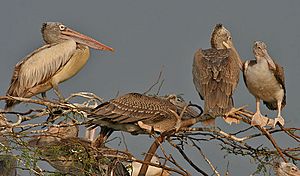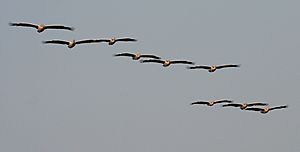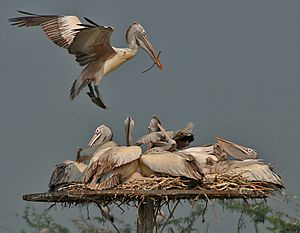Spot-billed pelican facts for kids
Quick facts for kids Spot-billed pelican |
|
|---|---|
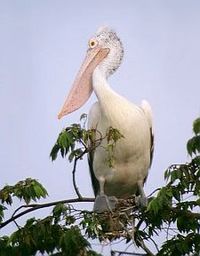 |
|
| Conservation status | |
| Scientific classification | |
| Kingdom: | |
| Class: | |
| Order: | |
| Family: | |
| Genus: | |
| Binomial name | |
| Pelecanus philippensis |
|
The spot-billed pelican (Pelecanus philippensis) is a large water bird. It belongs to the pelican family. These birds live and breed in southern Asia, including parts of India and Sri Lanka. They prefer big inland waters and coastal areas, especially shallow lakes. Spot-billed pelicans build their nests from plants in trees. Usually, a female pelican lays three to four eggs at a time.
Contents
What Does a Spot-billed Pelican Look Like?
The spot-billed pelican is a medium-sized pelican. It is still a very large bird, though! It can be about 125 to 152 centimeters (49 to 60 inches) long. These birds weigh between 4.1 and 6 kilograms (9 to 13 pounds).
Most of their body is white. They have a grey crest on their head and a brownish tail. The feathers on their neck are curly, forming a greyish patch. Their large pouch, which they use to catch fish, is pink or purplish. It has pale spots. The sides of their upper beak also have spots. The very tip of their beak is yellow or orange.
When they are ready to breed, the skin at the base of their beak turns dark. The skin around their eyes becomes pink. When flying, they look similar to another type of pelican, the Dalmatian pelican. However, the spot-billed pelican has darker feathers on its inner wings. It also has a pale band along its main wing feathers. Its tail is more rounded.
Baby pelicans are born covered in white fluffy down. Later, their feathers change to a speckled grey color. The special spots on their beak only appear after they are about one year old. They get their full adult feathers when they are three years old.
Where Do Spot-billed Pelicans Live?
Spot-billed pelicans mainly breed in India, Sri Lanka, and Cambodia. Some birds from India fly to the Gangetic plains for winter. They love shallow freshwater areas. These pelicans do not migrate long distances. However, they do move around locally. They spread out more widely when it's not breeding season.
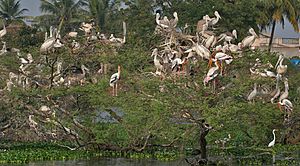
These birds like to nest in groups, called colonies. They often share their nesting areas with other water birds. Their nests are built on low trees near wetlands. Sometimes, they even nest close to towns or villages.
Many large pelican colonies have been recorded over time. Sadly, several of these colonies have disappeared. For example, a huge colony in Burma was once home to "millions" of pelicans. This colony was reported to have vanished by the 1940s. Another large colony in India, discovered in 1946, also disappeared around 1975.
Protecting Spot-billed Pelicans
The number of spot-billed pelicans has gone down. This is mainly because their homes (habitats) are being lost. Also, human activities sometimes disturb their nesting sites. Many groups of these pelicans in Southeast Asia are now gone. For instance, they were very common in the Philippines in the early 1900s. But by the 1960s, they had disappeared from there.
Good news! The number of pelicans in southern India seems to be growing. More protection efforts have helped them recover. Because of this, their conservation status was changed in 2007. They are now considered "near threatened." This means they are not in immediate danger, but we still need to watch out for them.
Images for kids
-
A pelican flying at Koonthankulam Bird Sanctuary, Tamil Nadu, India.
See also
 In Spanish: Pelícano oriental para niños
In Spanish: Pelícano oriental para niños



